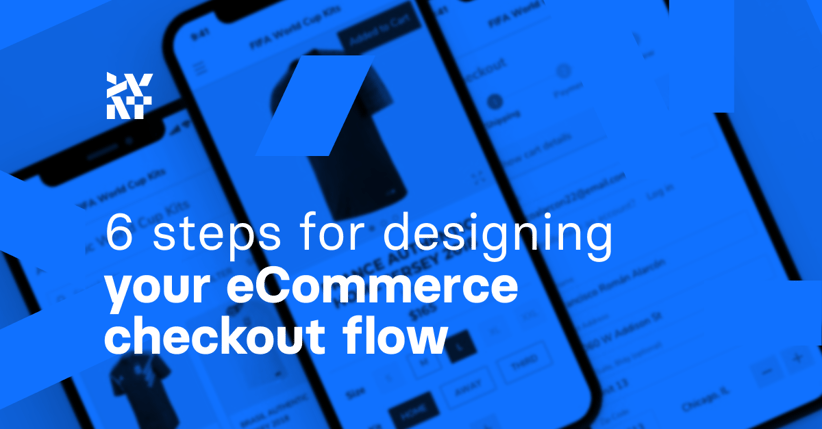Nearly 70% of website visitors abandon their shopping carts. That's a lot of lost sales. Yet, this is the reality for most eCommerce businesses.
There are many reasons why online shoppers don't follow through with their potential purchases. Some of those reasons include unexpected fees, a complicated checkout process, the absence of a guest checkout option, and a lack of trust.
You can reduce your cart abandonment rate by designing a streamlined checkout flow. This makes it easier for shoppers to complete their purchases. An optimized checkout process, coupled with cart abandonment recovery emails, will increase your sales. Here's how you can design a proper eCommerce checkout flow.
1. Simplify the purchase sequence
To get more people to purchase, ensure that the purchasing process is clean and straightforward. From the browsing stage, your user interface (UI) should be neat. A wild, distracting interface won't make the necessary buttons stand out. In eCommerce website design, your website's choice of visual elements impacts visitors' purchasing.
The process of purchasing itself should also be streamlined. Don’t dedicate an entire step to asking users if they want to subscribe to your newsletter. The fewer checkout steps, the better.
Ideally, your purchase sequence should just be the following:
- Have visitors input their personal information and shipping details.
- Ask visitors for their payment details and preferred mode of payment.
- Checkout and confirmation.
The faster you can get users to check out, the better. Anything that isn't listed above is best reserved for after the checkout. For example, you can ask users to create an account after they’ve made a purchase. You can also show a “verify your email” screen after they've checked out.
2. Ensure quicker page loading
You lose visitors to competition whose websites load quicker than yours. If your page load speed is above five seconds, your conversion rate is sliced in half. Imagine the effect this has on a checkout process with multiple steps.
A speedy, snappy website provides a positive brand experience. It encourages repeat purchasers and speeds up the checkout flow. Here's what you can do to achieve a quicker loading page.
- Remove unnecessary graphics and animations. This lessens the number of HTTP requests made to your server.
- Use smaller resolution media. You improve page load speed with smaller, compressed file sizes.
- Upgrade your servers depending on your daily traffic. Choose a package from your web hosting provider that can handle all of your website’s traffic.
- Monitor your page load speed. Google's Pagespeed Insights allows you to measure any website's page load speed. This is a helpful tool for comparing your site’s load speed against the competition.
Just as important is page uptime. You have to ensure that your eCommerce site is up 24/7. Every minute it's off the web is lost revenue. It's also aggravating for users to be interrupted by a lost server connection.
Optimizing your page speed and uptime will make eCommerce checkout flow smoother for customers. That’s not even mentioning the obvious SEO benefit of an optimized site’s speed.
3. Optimize your site for mobile devices
Mobile devices are ingrained in every aspect of our daily lives. Social media, content consumption, and personal communication are mostly done through mobile phones. Online shopping through a mobile device is more than just a trend.
Nearly 73% of global eCommerce sales are made through a mobile device. So, it's imperative that you optimize your store for both PC and mobile devices. Mobile users shouldn't need to zoom in to see your site. You also don’t want to have a graphic element blocking a vital checkout button.
Here's how you can achieve that:
- You can create a mobile version of your eCommerce website. Mobile users should be directed to this site.
- If you have the funding, create a progressive web app. Apart from a customized mobile experience, you can use it to send push notifications. You can also track user activity more efficiently.
Creating mobile-friendly websites is a method used by eCommerce and SaaS marketing teams. You don’t want your online store left behind. Coupled with a quicker load speed, you may see more impulse buying.
4. Avoid extra charges at checkout
One of the biggest reasons customers abandon their carts is unexpected fees. This happens when a shopper is about to check out and comes across additional charges they didn’t know about.
Taxes and customs are examples of common extra charges. If you’re in a region that requires extra taxes and customs, make sure to inform your shoppers in advance. Try as much as possible to avoid including the taxes at the very end when the shopper is about to check out. This can easily put them off and make them abandon the cart altogether.
Disclaimers, such as “subject to taxes,” may also help. You can place these disclaimers on your catalog and product pages. Calculate the tax for the shoppers and display it as shown above.
Shipping fees can also put off some shoppers. However, these are a bit easier to eliminate. Here's what you can do to sustainably slash shipping costs from your item.
- Provide free shipping coupon codes. You may email these to cart abandoners and loyal customers. You can also use them during promos.
- Factor in shipping to your product's retail cost. Customers don't want to pay for "nothing." To most customers, shipping is essentially that. Because of this, you can add the shipping expenses to the retail cost and provide “free shipping.”
Reducing shipping costs, or at least making it appear that way to the consumer, is a huge improvement to the entire checkout process. Have cash flow forecasting, too. This is so you know where you stand in terms of providing affordable shipping.
5. Provide an autosave feature
Another improvement you can make is saving customer data for a quicker checkout. It's a tiresome process to fill out form fields again and again. You have to enter your shipping address, credit card number, refill your cart, etc. each time you make a purchase. To some consumers, this is cumbersome, especially if they're frequent purchasers.
To encourage repeat purchases, give users an option to save their information. For example, ask for their consent to store their billing address and payment details.
Additionally, save the content in their shopping carts. By doing so, shoppers won't need to fill out form fields and restock their carts when they receive your cart abandonment email and decide to complete the checkout.
6. Add trust badges for credibility
People will be entering sensitive personal information into your site. This includes credit card information. So, your website must appear secure and certified to customers. You wouldn't give your credit card to a random stranger, would you?
Assure your online shoppers with trust badges. These badges are seals of approval from reputable third-party authorities. Display them prominently on your website so potential customers feel safe.
Apart from security badges, there are also accepted payment badges, third-party endorsements, and money-back guarantee badges. It’s important that you don’t use any badge that isn’t relevant to your company, meaning don’t use a free shipping badge if you don’t offer free shipping.
On top of that, you need to keep your SSL certificates up to date. Outdated certificates alert browsers and antivirus software and notify users that your site isn’t safe. Assuring users with badges boosts shoppers’ confidence in your store, resulting in more checkouts.
The takeaway
A clunky eCommerce checkout flow will cost you sales. Apart from that, you'll also ruin the brand experience for new and returning shoppers alike. You need to optimize your eCommerce checkout process to prevent these things from happening. Here's how:
- Simplify the purchase sequence. The fewer steps in the online checkout process, the better.
- Have a quick loading page. ECommerce sites must load quickly or else they lose out to the competition.
- Optimize the mobile experience, too.
- Avoid surprising your shoppers with additional fees at check out.
- Provide a cart autosave feature.
- Finally, update your SSL and use security badges. This lets users know they're dealing with a legitimate site.
Follow these steps, and you’ll have a streamlined eCommerce checkout process.
Published September 8, 2022











